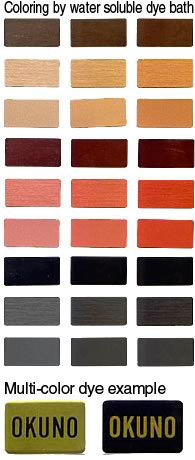#090 Anodic Oxidation Dying Process
Colored anodized products are widely used for ornamental items. Organic dyes are used in order to obtain a variety of colors. Normally, anodized coating with unsealed pores is immersed in an organic dye water solution. The dye penetrates the unsealed pores and the anodized layer is colored.
Therefore, low dye concentration and shorter immersion time is used for lighter dying, and vise versa.
As the process continues, the dye bath encounters lowering of dye concentrations, lowering of PH due to carry over infusion of electrolytes, and dying resistances due to chlorine and silicate ions from cleansing water.
In order to avoid these impediments, concentration adjustments and HP adjustments are carried out as well as use of de-ionized water.
In addition, multi-colored screen printing using paste form dyes as well as combination use with water soluble dye baths for a diverse variety of color expressions.
After the dying process, nickel chloride is generally used to seal the pores.

- Environmental conservation
- Hot Dipping
- Anodic Oxidation Process
- Anodic oxidation treatment
- Anodizing
- Corrosion - Corrosion Protection
- Electroless Plating
- Electroplating
- Heat treating
- Hydrogen embrittlement
- Metal cleaning
- Metal etching
- Painting
- Special paints
- Surface Treatment
- Surface-treated steel sheets
- Thermal Spraying



